AI in Precision Medicine Market Size
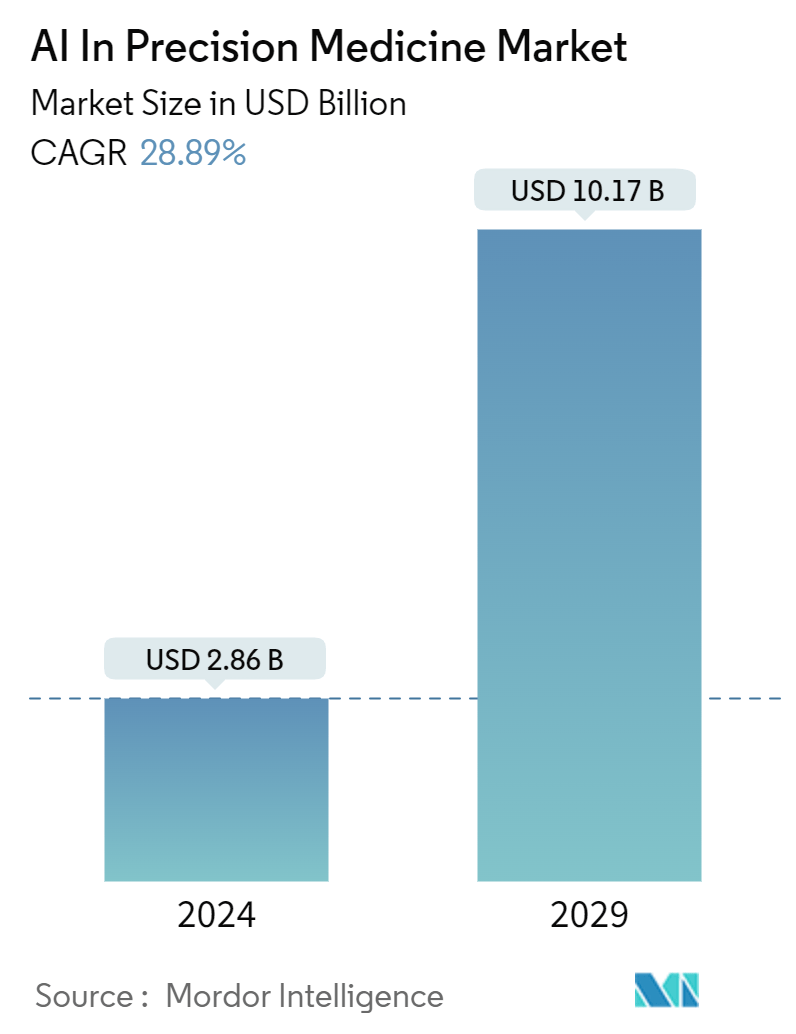
| Study Period | 2019 - 2029 |
| Market Size (2024) | USD 2.86 Billion |
| Market Size (2029) | USD 10.17 Billion |
| CAGR (2024 - 2029) | 28.89 % |
| Fastest Growing Market | Asia Pacific |
| Largest Market | North America |
Major Players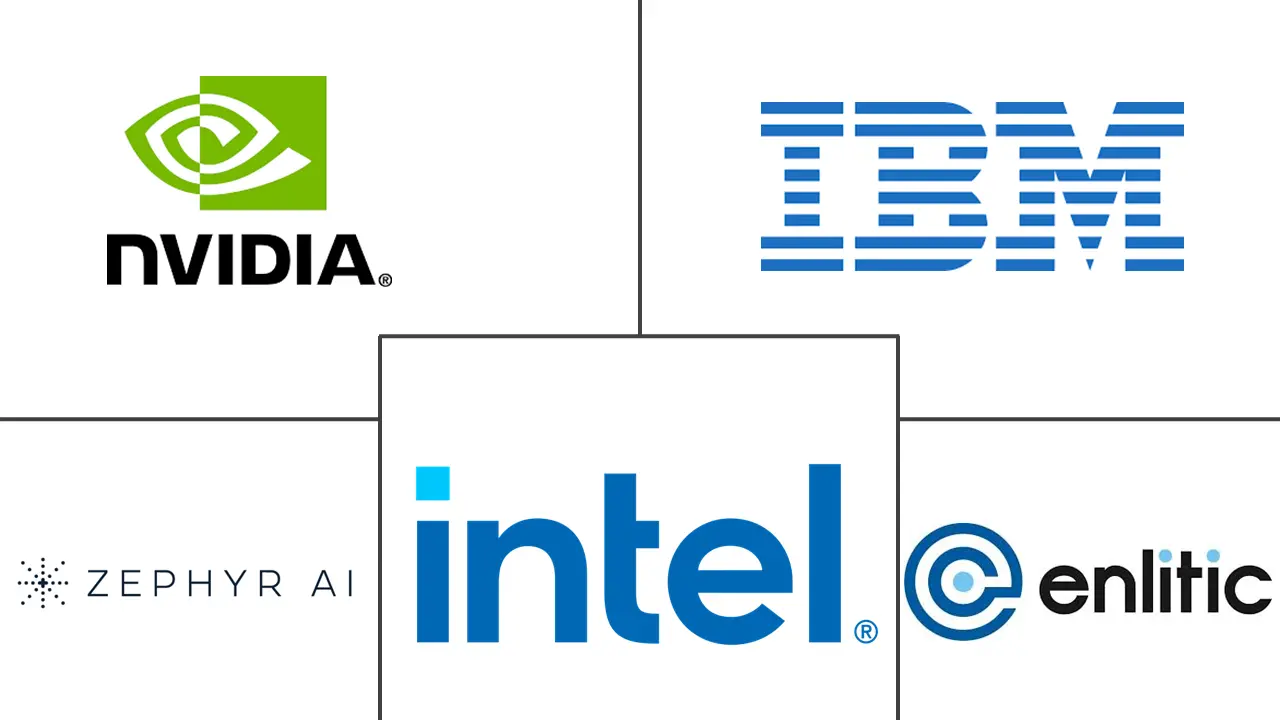
*Disclaimer: Major Players sorted in no particular order |
AI in Precision Medicine Market Analysis
The AI In Precision Medicine Market size is estimated at USD 2.86 billion in 2024, and is expected to reach USD 10.17 billion by 2029, growing at a CAGR of 28.89% during the forecast period (2024-2029).
The major factors driving the market are the rising demand for precision medication, increasing investment in research and development, the growing prevalence of chronic diseases, the rising geriatric population, and the increasing adoption of electronic health records.
The rising demand for precision medicine is increasing the adoption of artificial intelligence (AI) to generate insights and enable the system to reason, learn, and empower clinician decision-making through augmented intelligence, which is expected to drive the market over the forecast period. For instance, in June 2024, the National Institute of Health provided funding of USD 5.6 million to researchers at UC Davis Health for the project Nutrition for Precision Health. The research investigates personalized diet recommendations to enhance health and prevent disease. In this research program, participants, genetic data is collected and analyzed using AI to generate insights. Hence, increasing demand for precision medicine is boosting investments in the research activities of precision medicine, which is expected to drive the market over the forecast period.
In precision medicine, electronic health records (EHRs) are used to obtain rich longitudinal data for large-scale precision medicine studies. Hence, the increasing adoption of EHR is increasing the utilization of AI, which can be used to analyze patient data from diverse sources, including patients' medical files, laboratory results, imaging reports, and even genetic data that can be used in precision medicine. Hence, the growing adoption of electronic health records is expected to drive the market over the forecast period. For instance, in June 2022, the United Kingdom’s National Health Service (NHS) committed to implementing electronic health records for all hospitals and community practices by 2025, backed by EUR 2 billion (USD 2.15 billion) in funding. Thus, government initiatives to increase the adoption of electronic health records are expected to drive the market over the forecast period.
Furthermore, increasing strategic activities, such as new solution launches, are also expected to drive the market over the forecast period. For instance, in May 2023, Google Cloud reported the launch of two new AI-powered solutions based on life sciences, Multiomics Suite and Target and Lead Identification Suite, to accelerate drug discovery and precision medicine for biotech companies, pharmaceutical firms, and public sector organizations. Hence, the launch of such solutions increases the accessibility of AI for developing precision medicine, which is expected to drive the market over the forecast period.
Thus, the rising demand for precision medicine, increasing adoption of electronic health records, and growing strategic activities such as the launch of new solutions are expected to drive the market over the forecast period. However, the high costs associated with precision medicines are expected to restrain market growth.
AI in Precision Medicine Market Trends
The Oncology Segment is Expected to Hold a Significant Market Share Over the Forecast Period.
In oncology, precision medicine uses specific information about a person’s tumor to help make a diagnosis, plan treatment, determine how well treatment is working, or make a prognosis. Precision medicine may also help determine a person’s risk of developing certain types of cancer. Machine learning and deep learning of subsets of AI can be used to mine the deep-level information in genomics, transcriptomics, proteomics, radionics, and digital pathological images, which can help clinicians understand tumors and prescribe medication accordingly.
The rising prevalence of cancer cases, increasing research and development funding, and growing strategic activities by key players are expected to drive the market over the forecast period.
The rising prevalence of cancer cases globally is increasing the demand for precision medicine, where artificial intelligence can be used to study the genetic composition of tumors in different patients efficiently and provide a treatment plan that reduces the adverse effects of oncology therapeutics. For instance, according to the American Cancer Society 2024 update, about 2 million new cancer cases are expected to be diagnosed in the United States in 2024. Also, every day, around 5,480 cases of new cancer are likely to be identified in the United States. Hence, the rising number of cancer cases is expected to drive the segment over the forecast period.
The increasing adoption of AI solutions in the development of precision medicine used in the treatment of cancer is also expected to drive the market over the forecast period. For instance, in April 2023, Certis Oncology Solutions, a precision oncology and translational science company focused on combining functional assays and artificial intelligence (AI) to advance personalized medicine, reported the launch of CertisAI, a predictive medicine platform that utilizes big data, statistical algorithms, and machine learning (ML) to predict drug efficacy based on gene expression biomarkers. Hence, the adoption of artificial intelligence in the development of cancer therapeutics is also expected to drive the market over the forecast period.
Hence, the rising prevalence of cancer cases and the growing adoption of artificial intelligence in oncology research to develop precision medicines are expected to drive the segment over the forecast period.
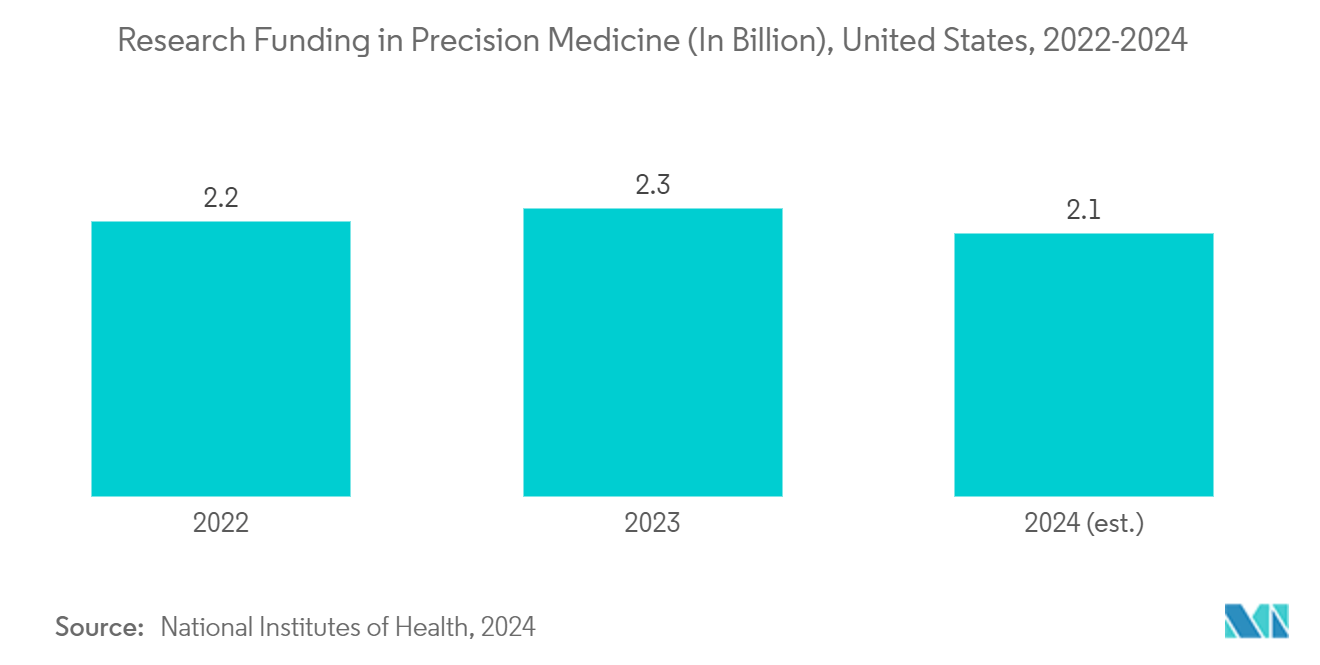
North America is Expected to Hold a Significant Market Share Over the Forecast Period
North America holds a significant market share. This is due to the rising prevalence of chronic diseases in the region, increasing research activities for the development of precision medicine using AI, and growing strategic activities such as acquisitions by key players.
The increasing investments in research activities for the development of precision medicine that uses AI are expected to increase the adoption of AI technologies, driving the market over the forecast period. For instance, in January 2024, Penn Medicine, a clinical and research entity of the University of Pennsylvania, developed an AI tool for precision oncology known as iStar. This application gives clinicians more insights into gene activities in medical images and, potentially, helps them diagnose cancers that might have otherwise been undetected. Hence, the development of such artificial applications is expected to increase the accessibility of AI technologies in precision medicine.
The increasing number of chronic diseases, such as cancer, raises the demand for AI to analyze various genetic data and develop a patient-specific treatment plan that can have minimum adverse effects. For instance, as per the November 2023 update by the Canadian Cancer Society, about 239.1 thousand Canadians were diagnosed with cancer in 2023, in which 2 in 5 Canadians are expected to develop cancer in their lifetime. Thus, the high prevalence of cancer among the population necessitates the demand for AI technologies, which is expected to fuel the market’s growth over the forecast period.
The rise in strategic activities, such as the launch of new AI solutions in precision medicine, is also expected to drive the market over the forecast period. For instance, in May 2024, OM1, a US technology company, launched three new products, OM1 Orion, OM1 Lyra, and OM1 Polaris, powered by PhenOM, an artificial intelligence-powered digital phenotyping platform for personalized medicine and clinical research. Hence, the launch of such products by key players is expected to drive the market over the forecast period.
Therefore, the increasing research and development activities in precision medicine, the rising prevalence of cancer, and growing strategic activities, such as the launch of new AI solutions, are expected to drive the market over the forecast period.
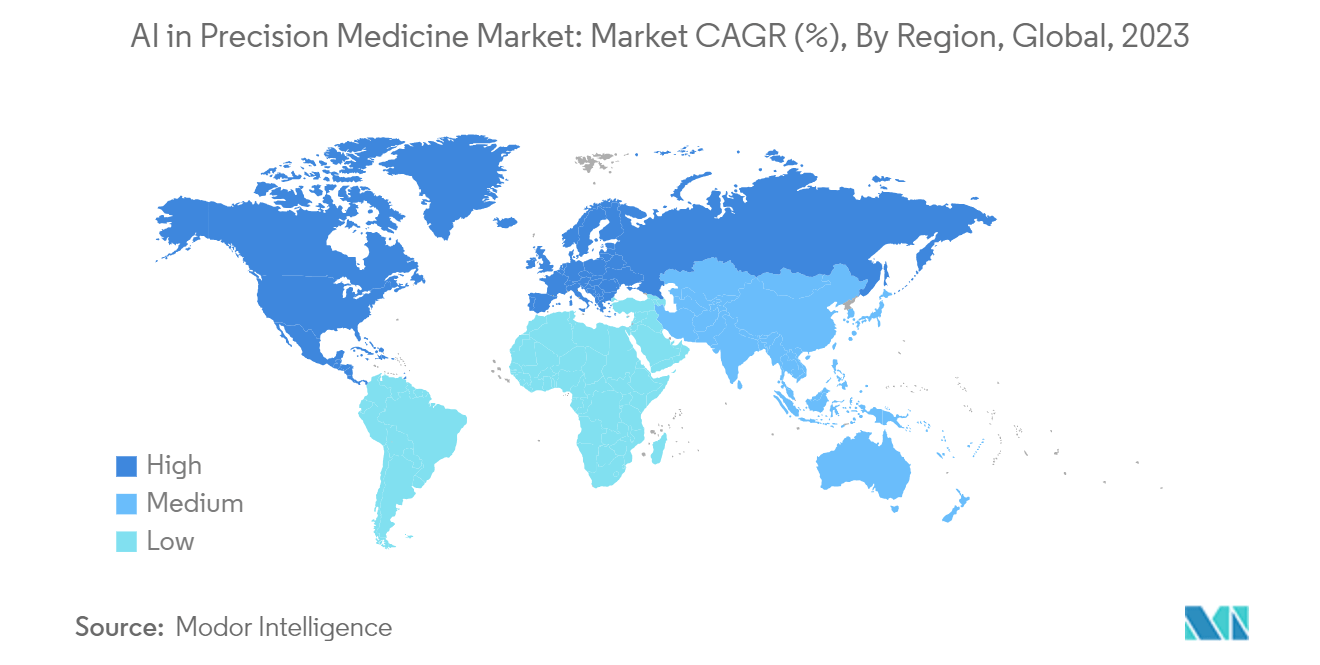
AI in Precision Medicine Industry Overview
The market for AI in precision medicine is consolidated due to the presence of a few major companies. These players are adopting various strategic activities such as mergers, collaborations, and expansions to strengthen their geographical presence and expand their customer base. Some of the key players in the market include NVIDIA Corporation, Intel Corporation, Enlitic Inc., Zephyr AI, and IBM.
AI in Precision Medicine Market Leaders
-
NVIDIA Corporation
-
Intel Corporation
-
Enlitic, Inc
-
Zephyr AI
-
IBM
*Disclaimer: Major Players sorted in no particular order
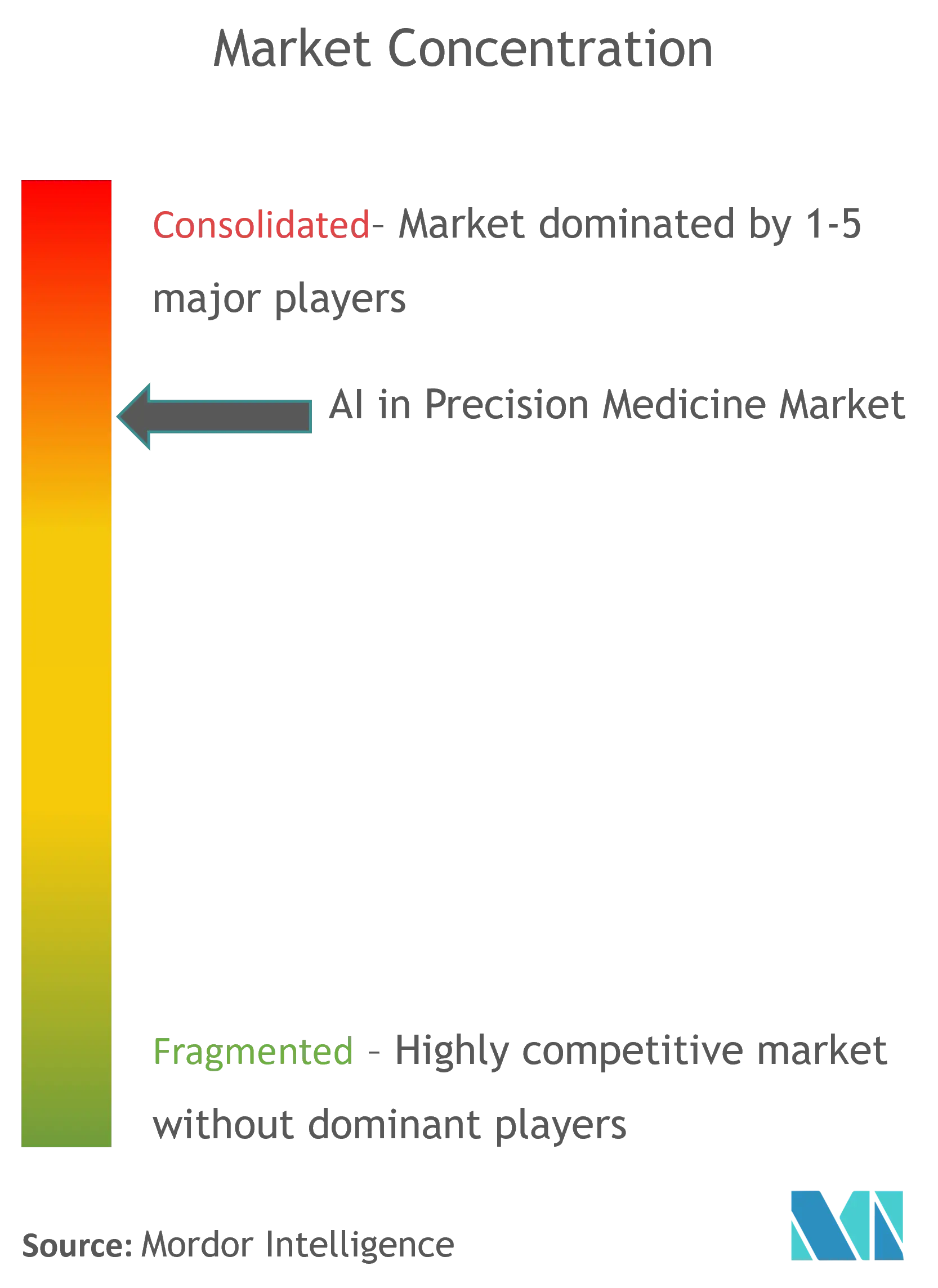
AI in Precision Medicine Market News
February 2024: Exscientia PLC, an AI-driven precision medicine company, reported the initiation of EXCYTE-2, an observational clinical study in acute myeloid leukemia (AML), to investigate the relationship between ex vivo drug response (EVDR) measured in primary blood or bone marrow samples using the company’s deep learning, single-cell precision medicine platform and actual patient clinical response.
June 2023: Dartmouth, an Ivy League research university, launched the Center for Precision Health and Artificial Intelligence (CPHAI) to advance interdisciplinary research into how artificial intelligence (AI) and biomedical data can be used to improve precision medicine and health outcomes.
AI in Precision Medicine Market Report - Table of Contents
1. INTRODUCTION
- 1.1 Study Assumptions and market definitions
- 1.2 Scope of the Study
2. RESEARCH METHODOLOGY
3. EXECUTIVE SUMMARY
4. MARKET DYNAMICS
- 4.1 Market Overview
-
4.2 Market Drivers
- 4.2.1 Rising Demand for Precision Medications
- 4.2.2 Growing Adoption of Electronic Health Records
-
4.3 Market Restraints
- 4.3.1 High Cost Associated With Precision Medicine
-
4.4 Porter's Five Force Analysis
- 4.4.1 Threat of New Entrants
- 4.4.2 Bargaining Power of Buyers/Consumers
- 4.4.3 Bargaining Power of Suppliers
- 4.4.4 Threat of Substitute Products
- 4.4.5 Intensity of Competitive Rivalry
5. MARKET SEGMENTATION (Market Size by Value - USD)
-
5.1 By Technology
- 5.1.1 Deep Learning
- 5.1.2 Querying Method
- 5.1.3 Natural Language Processing
- 5.1.4 Context-Aware Processing
-
5.2 By Component
- 5.2.1 Hardware
- 5.2.2 Software
- 5.2.3 Service
-
5.3 By Therapeutic Application
- 5.3.1 Oncology
- 5.3.2 Cardiology
- 5.3.3 Neurology
- 5.3.4 Respiratory
- 5.3.5 Others (Ophthalmology, Dentistry and Others)
-
5.4 Geography
- 5.4.1 North America
- 5.4.1.1 United States
- 5.4.1.2 Canada
- 5.4.1.3 Mexico
- 5.4.2 Europe
- 5.4.2.1 Germany
- 5.4.2.2 United Kingdom
- 5.4.2.3 France
- 5.4.2.4 Italy
- 5.4.2.5 Spain
- 5.4.2.6 Rest of Europe
- 5.4.3 Asia-Pacific
- 5.4.3.1 China
- 5.4.3.2 Japan
- 5.4.3.3 India
- 5.4.3.4 Australia
- 5.4.3.5 South Korea
- 5.4.3.6 Rest of Asia-Pacific
- 5.4.4 Middle East and Africa
- 5.4.4.1 GCC
- 5.4.4.2 South Africa
- 5.4.4.3 Rest of Middle East and Africa
- 5.4.5 South America
- 5.4.5.1 Brazil
- 5.4.5.2 Argentina
- 5.4.5.3 Rest of South America
6. COMPETITIVE LANDSCAPE
-
6.1 Company Profiles
- 6.1.1 BioXcel Therapeutics Inc.
- 6.1.2 Sanofi SA
- 6.1.3 NVIDIA Corporation
- 6.1.4 Google Inc.
- 6.1.5 IBM
- 6.1.6 Microsoft
- 6.1.7 Intel Corporation
- 6.1.8 AstraZeneca PLC
- 6.1.9 Tempus AI
- 6.1.10 Enlitic, Inc.
- 6.1.11 Zephyr AI
- 6.1.12 Picturehealth
- 6.1.13 Valar Labs
- *List Not Exhaustive
7. MARKET OPPORTUNITIES AND FUTURE TRENDS
** Subject To AvailablityAI in Precision Medicine Industry Segmentation
As per the scope of the report, precision medicine designs and optimizes the pathway for diagnosis, therapeutic intervention, and prognosis by using large multidimensional biological datasets that capture individual variability in gene function and environment. These datasets can be analyzed by artificial intelligence to predict risk in various diseases for tailored treatment plans.
The AI in precision medicine market is segmented by technology, components, therapeutic applications, and geography. By technology, the market is segmented into deep learning, querying methods, natural language processing, and context-aware processing. By component, the market is segmented into hardware, software, and services. By therapeutic application, the market is segmented into oncology, cardiology, neurology, respiratory, and others (ophthalmology and dentistry). By geography, the market is segmented into North America, Europe, Asia-Pacific, Middle East and Africa, and South America. The report also covers the estimated market sizes and trends for 17 countries across major regions globally. The report offers values (USD) for all the above segments.
| By Technology | Deep Learning | |
| Querying Method | ||
| Natural Language Processing | ||
| Context-Aware Processing | ||
| By Component | Hardware | |
| Software | ||
| Service | ||
| By Therapeutic Application | Oncology | |
| Cardiology | ||
| Neurology | ||
| Respiratory | ||
| Others (Ophthalmology, Dentistry and Others) | ||
| Geography | North America | United States |
| Canada | ||
| Mexico | ||
| Geography | Europe | Germany |
| United Kingdom | ||
| France | ||
| Italy | ||
| Spain | ||
| Rest of Europe | ||
| Geography | Asia-Pacific | China |
| Japan | ||
| India | ||
| Australia | ||
| South Korea | ||
| Rest of Asia-Pacific | ||
| Geography | Middle East and Africa | GCC |
| South Africa | ||
| Rest of Middle East and Africa | ||
| Geography | South America | Brazil |
| Argentina | ||
| Rest of South America |
AI in Precision Medicine Market Research FAQs
How big is the AI In Precision Medicine Market?
The AI In Precision Medicine Market size is expected to reach USD 2.86 billion in 2024 and grow at a CAGR of 28.89% to reach USD 10.17 billion by 2029.
What is the current AI In Precision Medicine Market size?
In 2024, the AI In Precision Medicine Market size is expected to reach USD 2.86 billion.
Who are the key players in AI In Precision Medicine Market?
NVIDIA Corporation, Intel Corporation, Enlitic, Inc, Zephyr AI and IBM are the major companies operating in the AI In Precision Medicine Market.
Which is the fastest growing region in AI In Precision Medicine Market?
Asia Pacific is estimated to grow at the highest CAGR over the forecast period (2024-2029).
Which region has the biggest share in AI In Precision Medicine Market?
In 2024, the North America accounts for the largest market share in AI In Precision Medicine Market.
What years does this AI In Precision Medicine Market cover, and what was the market size in 2023?
In 2023, the AI In Precision Medicine Market size was estimated at USD 2.03 billion. The report covers the AI In Precision Medicine Market historical market size for years: 2019, 2020, 2021, 2022 and 2023. The report also forecasts the AI In Precision Medicine Market size for years: 2024, 2025, 2026, 2027, 2028 and 2029.
AI in Precision Medicine Industry Report
Statistics for the 2024 AI In Precision Medicine market share, size and revenue growth rate, created by Mordor Intelligence™ Industry Reports. AI In Precision Medicine analysis includes a market forecast outlook for 2024 to 2029 and historical overview. Get a sample of this industry analysis as a free report PDF download.



